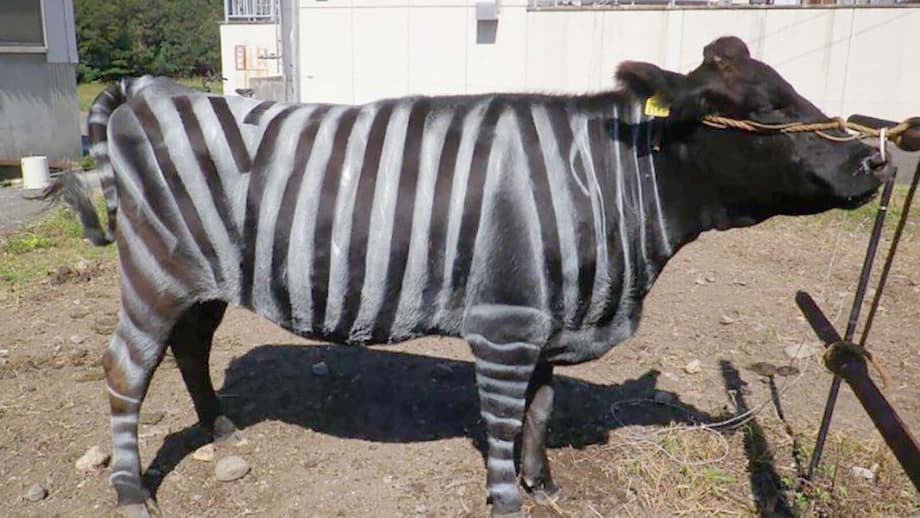A playful prize with a practical payoff
A simple paint job has earned a serious honor. On September 18, 2025, at Boston University, a team of Japanese researchers received the Ig Nobel Prize in biology for showing that painting cows with bold black and white stripes can cut fly landings by about half. The Ig Nobels, created in 1991 by the magazine Annals of Improbable Research, celebrate work that makes people laugh, then think. The moment fit the mood: during the acceptance, team members waved fake flies and researcher Tomoki Kojima revealed a zebra patterned shirt to cheers from the audience.
The work highlights a low cost, pesticide free idea for one of farming’s most stubborn problems. Biting flies like stable flies and horseflies cause pain, open wounds and stress. They can reduce weight gain and milk yield, and they sometimes lead to infections that need treatment. Many farms lean on chemical insecticides and repellents, but resistance is a growing concern. By turning black cattle into lookalikes of zebras, the researchers found fewer bites and calmer animals, suggesting a new tool that fits with animal welfare goals and could lower chemical use.
In field tests with Japanese Black cattle, cows painted with white stripes had half as many flies landing on their legs and bodies as unpainted cows. They also showed fewer fly fighting behaviors such as head tossing and leg stamping. Black stripes on black coats did not work, which points to a visual effect rather than a scent from paint. The insights dovetail with long running questions about zebra stripes and how insects see. For Japan, the prize extends a remarkable streak, marking the 19th straight year in which the country’s researchers have won at least one Ig Nobel. The ceremony featured ten prizes across science and the arts.
Why paint cows like zebras
Biologists have debated the purpose of zebra stripes for generations. One leading idea is that the pattern helps deter biting flies. Insects find hosts using a mix of signals, including odor, body heat, movement, shape, color and the way surfaces reflect polarized light. High contrast stripes interfere with several of these cues at once, which can make it harder for a fly to lock on and land.
Black and white patches reflect light differently and shift polarization over very short distances. For a fly’s visual system, which depends on rapid changes in optic flow and polarization to judge speed and distance, that flicker can scramble approach and landing. Muscles under the hide add tiny movements that turn stripes into a shifting field of bright and dark. The result is a moving target the fly cannot easily interpret.
What makes stripes confusing to flies
Flies see through compound eyes that excel at detecting motion and patterns. As a fly approaches a uniform surface, optic flow is smooth and landing is straightforward. Stripes break that smooth flow into alternating bands, so the apparent motion of each band can conflict with the next. If the stripes also flip polarization rapidly, the scene loses consistency. The insect’s motor program for landing can falter. This is consistent with a core result from the cow study: white stripes against a dark coat change the visual scene, while black on black stripes do not.
Inside the experiment
The research team worked with Japanese Black cows, a breed often raised for wagyu beef. They rotated each animal through three treatments: white stripes painted on the dark coat using water based paint and masking tape, black stripes on the same dark coat to control for paint odor and handling, and no paint. Observers counted fly landings on the body and legs and recorded fly shooing behaviors such as head shakes, tail flicks and leg stamps. The team repeated the setup in a second grazing season to check that the effect held across time.
White stripes made a clear difference. Compared with unpainted cows, striped animals attracted roughly 50 percent fewer flies and spent less time in defensive actions. Black stripes did not improve anything, which supports the idea that the visual pattern, not any smell from the paint, drives the effect. The paint, however, faded within days, so the researchers noted that a longer lasting method would be needed outside a test plot.
As word spread, farmers in Japan began exploring more durable, animal safe coatings and even patterning by bleaching hair. Field reports described good tolerance and no negative effects on the cattle. Practical routines, including how often to reapply and how to handle large herds, are still being refined.
Kojima, who works at the National Agriculture and Food Research Organization (NARO), said the project started when a cattle farmer asked for help with biting insects. A television segment about zebra stripes sparked the idea of testing a visual trick on cows.
At the ceremony, Kojima also spoke about the people behind the project.
We are grateful to our colleagues, friends and families.
He added that recognition would fuel future work to make the approach more practical for farms.
This award will motivate our team to keep trying.
Animal welfare and the price of flies
Stable flies and horseflies do not just annoy cattle. They pierce skin and feed on blood, leaving painful welts. The stress and wounds can lead to infections, reduced feeding and disrupted rest. Over a season, that can mean lower weight gain and milk production. Industry estimates put the yearly cost of biting flies to the United States cattle sector at about 2.2 billion dollars, which includes lost output and treatment expenses.
Producers use several countermeasures, such as insecticide ear tags, pour on treatments, sprays, trapped bait and barn fans. Each tool has limits. Heavy chemical use can drive resistance and carries environmental and worker safety concerns. A visual deterrent adds a different lever. If stripes reduce landing rates, fewer flies bite, which may lower the need for chemicals and ease stress. Calmer animals spend more time eating and resting, and wounds have a better chance to heal.
On some wagyu farms, animals graze less during peak fly season because of pest pressure. Any reduction in bites outdoors gives producers more flexibility and can support welfare goals. A pattern that helps cattle in fields and pens would also benefit handlers, since swarming flies bother people and spread pathogens between surfaces.
Can farms use this at scale
The early studies used water based paint that faded within days, so durability and labor are the main hurdles. Painting an entire herd takes time, and rain, mud and grooming degrade the pattern. Japanese producers have piloted more robust, animal safe formulations and bleaching of coat hair to create white stripes that last longer. Some have tried stencils and rollers to speed up application during routine handling.
There is also a question of pattern details. The study used vertical white stripes on black coats. Stripe width, spacing and orientation might matter for different fly species or under different light. Breeds with lighter coats may need darker stripes to create strong contrast. Trials across regions and seasons will clarify what works best, and whether a simple template can deliver most of the benefit.
Cost will come down to labor. The materials are inexpensive. If stripes cut infections and reduce the need for insecticide treatments, the balance may favor the approach in small and mid size herds. In large operations, mechanized sprayers or paint stations at chutes could make the method practical. Even partial adoption during peak fly months could help.
Kojima has said the method could reduce pesticide use and ease concerns about resistance in the environment. The idea is to add a visual barrier so farms need fewer chemicals, not to replace every other tool. That aligns with integrated pest management, where multiple measures work together for a better outcome.
A light hearted ceremony with serious science
The Ig Nobel Prizes have a reputation for joy and curiosity. Nobel laureates present the awards. Audience members throw paper airplanes. Each year has a playful theme, and this time the ceremony featured a mini opera with a digestion thread. Winners receive a tongue in cheek keepsake and a flood of attention from classrooms and labs, where odd ideas often grow into real advances.
The founder of the awards summed up the ethos in a way that fits both zebra cows and pizza loving lizards.
Every Ig Nobel prize winner has done something that first makes people laugh, and then makes them think.
The cow study shared the stage with other research that was unusual yet insightful. A few standouts:
- Testing whether adding Teflon to food could bulk it up without adding calories.
- Pinpointing when cacio e pepe sauce starts to clump and how to keep it smooth.
- Finding that rainbow lizards in Togo prefer four cheese pizza over other toppings.
- Showing that a mother eating garlic makes breastmilk smell of garlic, which babies tend to accept.
- Measuring whether a drink can help a person speak a foreign language more fluidly, with Dutch as the test case.
- Studying how alcohol affects bats, including their flying and echolocation.
- Documenting the growth of a single fingernail over 35 years.
- Exploring how foul smelling shoes affect the experience of using a shoe rack from a design perspective.
Key Points
- Japanese researchers won the 2025 Ig Nobel Prize in biology for painting cows with white stripes to repel flies.
- Striped cows had about 50 percent fewer fly landings and showed fewer defensive movements than unpainted cows.
- Black stripes on black coats did not help, which supports a visual mechanism rather than any paint odor.
- The paint used in tests faded within days, so farmers are exploring longer lasting coatings and hair bleaching patterns.
- Stable flies and horseflies cost the U.S. cattle industry an estimated 2.2 billion dollars per year.
- The approach could reduce pesticide use and help with resistance concerns as part of integrated pest management.
- Japan has won at least one Ig Nobel for 19 consecutive years, and this year’s ceremony took place at Boston University.
- Other winners included work on Teflon in food, pasta sauce physics, lizard pizza preferences and alcohol effects on language and bats.




